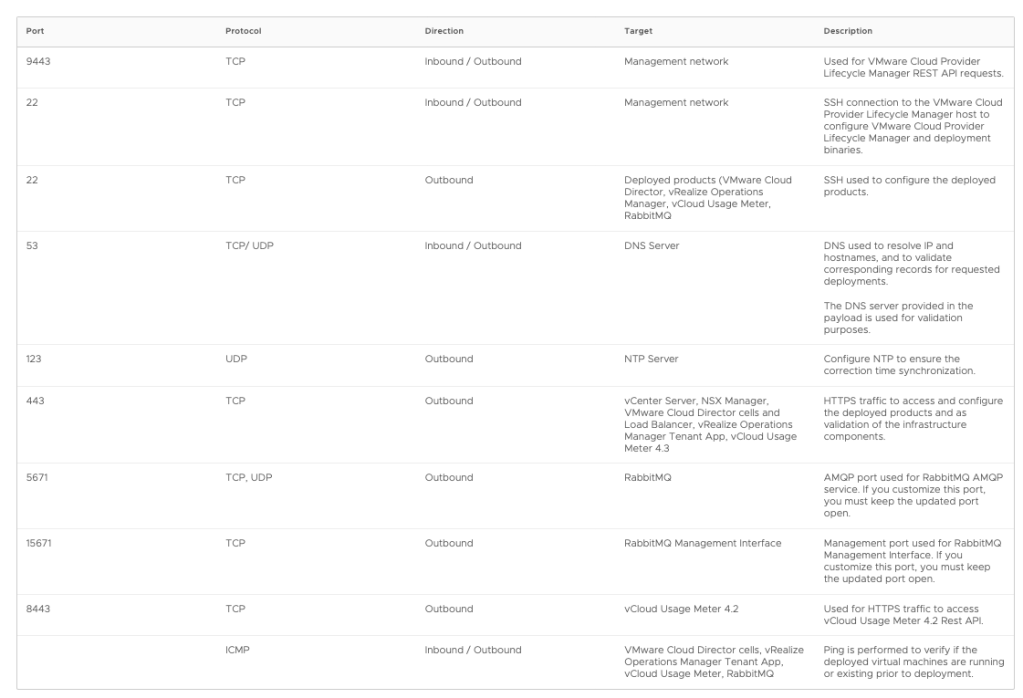VMware Cloud Provider Lifecycle Manager simplifies the operational experience by providing a comprehensive solution to deploy, upgrade, configure, and manage the VMware Cloud Provider products.
To enable tasks for VMware Cloud Provider products, VMware Cloud Provider Lifecycle Manager provides REST APIs.
To deploy and manage a VMware Cloud Provider product, VMware Cloud Provider Lifecycle Manager requires a definition of the REST API request and the product binaries.
VMware Cloud Provider Lifecycle Manager needs access to the repository containing the OVA files, upgrade packages, etc.

VMware Cloud Provider Lifecycle Manager is delivered as a Docker image. To run VMware Cloud Provider Lifecycle Manager, you can configure a host running Photon OS on which you start the docker service and run the docker image.
VMware Cloud Provider Lifecycle Manager Port List

To run the VMware Cloud Provider Lifecycle Manager docker image, you must first configure the host environment. Create repository directories for storing the log files, certificates, and product OVA files, and update files.
After creating the repository directories, you configure the permissions for every directory. As a result, the files within the directory inherit the permissions you configure on the directory level.
To run VMware Cloud Provider Lifecycle Manager, after uploading the VMware Cloud Provider Lifecycle Manager docker image to the Photon OS virtual machine, you must start the docker container. Use the API version and session ID to authenticate and run requests against VMware Cloud Provider Lifecycle Manager.
To deploy a product, on the VMware Cloud Provider Lifecycle Manager host, first you must create the respective product environment.
VMware Cloud Director prerequisites:



- The VMware Cloud Director cells must have access to the NFS share. Before deploying VMware Cloud Director, the NFS share must be empty and read/write access must be enabled without authentication.
- VMware Cloud Director Load Balancer – before deploying the VMware Cloud Director cell, you must configure the dedicated load balancer.
- To enable forward and reverse lookup of IP addresses and hostnames, you must configure DNS A and PTR records for each VMware Cloud Director cell and load balancer.
- To deploy VMware Cloud Director with CA-signed certificates, you must generate the required certificates and provide them in the REST API payload.
- PVDC:
- vCenter cluster or dedicated resource pool available to be configured for PVDC (if root resource pool of the cluster is used, no resource pool name should be specified)
- Storage profile preconfigured in vCenter, including compliant datastores
- NSX-T Manager is accessible and provides overlay transport zone that can be used for network pool.
- NSX-T tier0 gateway is available and a subnet that is accessible to be used for configuring a VCD external network
vRealize Operations Manager prerequisites:


- Deploy vRealize Operations Manager and enable the access from vRealize Operations Manager Tenant App to vRealize Operations Manager.
- DNS A and PTR records have to exist for the vRealize Operations Manager Tenant App appliance to enable forward and reverse lookup of IP addresses and hostnames.
vCloud Usage Meter prerequisites:


- To automate the reporting, aggregation, and pre-filling of vCloud Usage Meter product consumption data, after deploying vCloud Usage Meter, you must register the vCloud Usage Meter instance with VMware Cloud Provider Commerce Portal. You cannot configure the vCloud Usage Meter integration with VMware Cloud Provider Lifecycle Manager before registering the vCloud Usage Meter instance with VMware Cloud Provider Commerce Portal.
- DNS – DNS A and PTR records have to exist for the vCloud Usage Meter appliance to enable forward and reverse lookup of IP addresses and hostnames.
RabbitMQ prerequisites:


To provide access to all RabbitMQ instances, you must configure the RabbitMQ load balancer. DNS – DNS A and PTR records must exist for each RabbitMQ instance and the load balancer to enable forward and reverse lookup of IP addresses and hostnames.
Next time I will be showing how to Upgrade a product using VMware Cloud Provider Lifecycle Manager.




